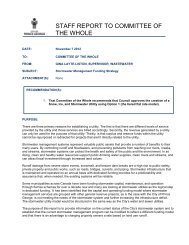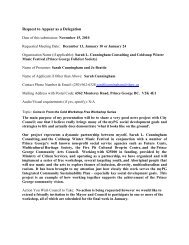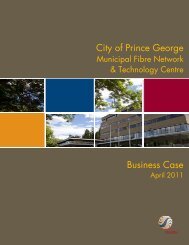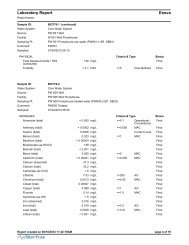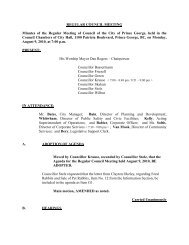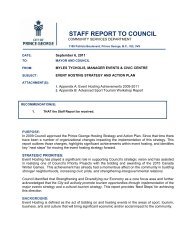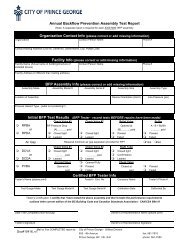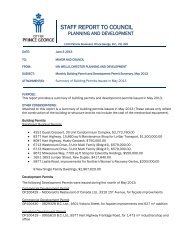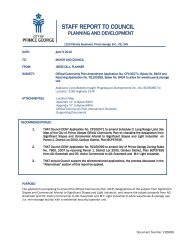Blackburn Wastewater Treatment Plant Upgrade Study
Blackburn Wastewater Treatment Plant Upgrade Study
Blackburn Wastewater Treatment Plant Upgrade Study
You also want an ePaper? Increase the reach of your titles
YUMPU automatically turns print PDFs into web optimized ePapers that Google loves.
Section 1.0 -Project Background and Objectives<br />
Physical characteristics of the underground piping (old/new/materials).<br />
rn<br />
Connection policies (roof drain connections, etc.).<br />
Review of wet weather flow mitigation policies and plans is essential. Should a<br />
reduction program prove practicable and cost effective, lower peak flows would occur<br />
after changes are implemented and thereby defer expanding plant infrastructure.<br />
1.7.6 Wet Weather Flows<br />
As detailed in the Stantec Consulting Ltd. report completed June, 1999, VI is a serious<br />
problem in the <strong>Blackburn</strong> sewage collection area and corrective action is required.<br />
The original 1976 design information for the Blackbum treatment facility lists the<br />
following criteria:<br />
rn Contributing population 2,500<br />
ADWF, m3/d 945<br />
In the future, as development exceeds 2,500 population, the facility would be doubled<br />
in capacity to accommodate a population of 5,000 with ADWF doubling, but PWWF<br />
remaining constant.<br />
Based on these design parameters, the lagoon facility would provide an eMuent<br />
quality of BOD6 20 mg/L and TSS< 20 mfl. Monitoring data from the City<br />
indicates that the facility up to now has reliably achieved these two targets and is in<br />
compliance with pennit requirements.<br />
It is important to note that the original design appears to have taken into consideration<br />
not only winter operating conditions, but also identified flow variations due to winter<br />
thaw conditions and spring raidthaw conditions. In the first stage of development,<br />
during wintedspring thaw conditions, because of the layout and locations of manholes<br />
and the coliection pipework, PWWF would be high, amounting to nearly 4.5 times<br />
ADWF, primarily because of inflow due to flooding around manholes adjacent to<br />
natural drainage streams. A second component would be due to infiltration due to wet<br />
ground andtor high groundwater conditions in Iow lying areas. In the second stage of<br />
development, UI would be reduced so that PWWF would remain at 4,350 m3/d and the<br />
PWWFlADWF ratio reduced to approximately 2.5.<br />
. .<br />
1<br />
,& 1 .<br />
- 1-9<br />
H .*mIIrnn>.3C*,,mmId Wnxll m<br />
mmm




